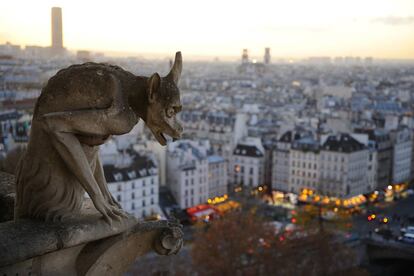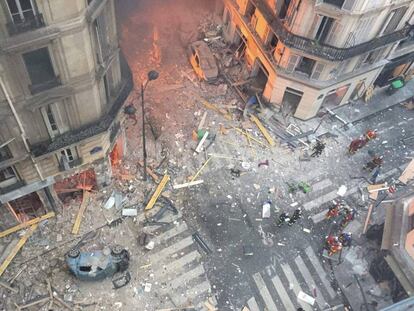Notre-Dame de Paris: where all the paths in France converge
One of the most powerful symbols of Europe will overcome the fire, just as it has resisted other disasters throughout the centuries


During the Paris Commune, in 1871, when the revolutionaries knew themselves to be defeated, they began torching all the public buildings in their path, with a special preference for churches. Yet Notre-Dame, the cathedral that occupies the geographical center of the French capital, was spared from the popular fury (a few pews burned down, but the fire went out without doing much damage), just like it had managed to survive the iconoclasm of the French Revolution a century earlier. Construction on the building began in the 12th century, with the Gothic style in full swing, and ended in the 1800s, and the cathedral became one of the most powerful symbols not just of France, but of Europe itself.
It is a symbol of Paris, it is much more than a cathedral
José Enrique Ruiz-Domènech, UAB professor
The façade with its twin towers, the spire that was built in the 19th century by Eugène Viollet-le-Duc, the gargoyles and the porticoes...over the course of the centuries, all of these elements have made Notre-Dame much more than a monument of stone and wood: there is an imaginary structure that is as real as the physical one. That is why the Monday fire has caused a collective commotion: all the roads of France pass under its arches – all the memories, the dreams and the fractures of a nation.
It is no coincidence that the monument’s current look was designed during the 19th century, under the great reform led by Viollet-le-Duc. This reform was highly controversial at the time, even if, just like the Eiffel Tower, the resulting building has become an integral part of the Parisian landscape. It was the century that gave birth to the collective myths that European nations grew on, and Gothic Revival architecture was a part of that.
It was here that a Mass was held after the liberation of Paris
It was also the century when Victor Hugo wrote the novel that would have a lasting effect on the cathedral: Notre-Dame de Paris, known as The Hunchback of Notre-Dame in English and in its multiple Hollywood versions. The story of Quasimodo and Esmeralda reconstructed 15th-century Paris, although the writer took many liberties in doing so, again underscoring the imaginary space over the real one. When one contemplates the cathedral’s gargoyles, many of which were built during that time, it is impossible not to think about Hugo’s characters.
“It is a symbol of Paris, it is much more than a cathedral,” explains José Enrique Ruiz-Domènech, a professor of medieval history at Barcelona’s Autónoma University (UAB) and a leading European scholar of medieval times. While he talks, he keeps receiving photographs on his cellphone, sent by his friends in Paris who cannot believe that something like this could be happening. Ruiz-Domènech, who taught in Paris for many years, also expresses disbelief. “Gothic art is the only art that managed to occupy the entire European space,” he says. “It is an emblem of European construction, an emblem of reason.”
It would be impossible to keep track of how many movies it has appeared in
This place of worship played a key role in the history of music because of its role in the adoption of polyphony. It is also where Napoleon was crowned emperor of the French, and where state funerals were held for the presidents De Gaulle, Pompidou and Mitterrand, and for the victims of the attacks of November 13, 2015. It was here that a Mass was held after the liberation of Paris, on August 26, 1944, in what may be the single most important moment in French contemporary history. Naturally, the cathedral is a Unesco World Heritage Site. Paris itself was born on an island whose center is occupied by Notre-Dame, and it grew out from there. It doesn’t matter how much the city has expanded since then: Notre-Dame never gave up its central role, and not just for visitors.
It would be impossible to keep track of how many movies it has appeared in – so much so that it has almost become a cliché. Notre-Dame has resisted the Commune, the Disney films, the effects of 19th-century kitsch, the impact of nearly 13 million visitors, and it will also overcome the damage wrought by a fire on Holy Week before the shocked and incredulous stares of everyone who ever strolled along its parvis and under its vaults.
English version by Susana Urra.
Tu suscripción se está usando en otro dispositivo
¿Quieres añadir otro usuario a tu suscripción?
Si continúas leyendo en este dispositivo, no se podrá leer en el otro.
FlechaTu suscripción se está usando en otro dispositivo y solo puedes acceder a EL PAÍS desde un dispositivo a la vez.
Si quieres compartir tu cuenta, cambia tu suscripción a la modalidad Premium, así podrás añadir otro usuario. Cada uno accederá con su propia cuenta de email, lo que os permitirá personalizar vuestra experiencia en EL PAÍS.
¿Tienes una suscripción de empresa? Accede aquí para contratar más cuentas.
En el caso de no saber quién está usando tu cuenta, te recomendamos cambiar tu contraseña aquí.
Si decides continuar compartiendo tu cuenta, este mensaje se mostrará en tu dispositivo y en el de la otra persona que está usando tu cuenta de forma indefinida, afectando a tu experiencia de lectura. Puedes consultar aquí los términos y condiciones de la suscripción digital.










































